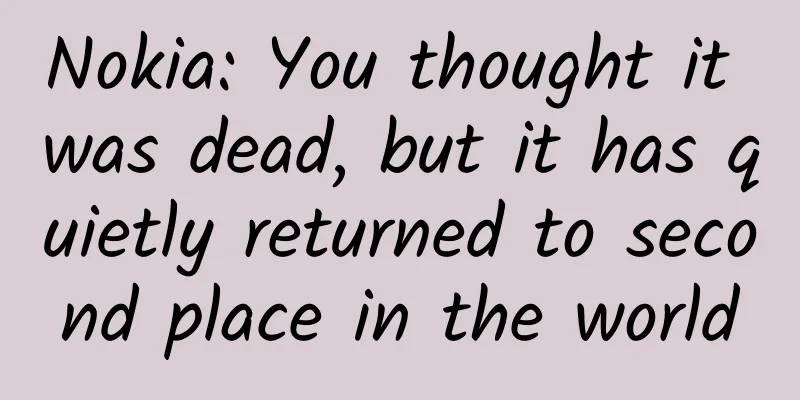Nokia: You thought it was dead, but it has quietly returned to second place in the world

|
Nokia was once the king. It once had: the best industrial design, the best mobile phone quality, the highest brand value, the most user recognition, the largest market share, and the highest brand premium. In its 150-year history, Nokia's conservative and closed strategies have brought it to the brink of bankruptcy many times, but its focus and mergers and acquisitions strategy has also allowed it to repeatedly escape danger and return to the top. In 2015, Nokia announced the acquisition of Alcatel-Lucent. In 2016, the acquisition was completed and its annual revenue surpassed Ericsson to become the world's second largest communications equipment manufacturer. Nokia is a great company, and its history is a typical company's self-salvation and transformation and rebirth. The wood pulp workshop was acquired into the first logo of the diversified group Nokia. In 1865, mining engineer Frederick Edelstein established a wood pulp factory by a river in the town of Tampere, Finland. The factory was located at the junction of Finland and the Russian Empire, and used local trees as raw materials to produce wood pulp and paperboard. By 1967, Nokia had become a large group company spanning papermaking, chemicals, rubber, energy, communications and other fields. Cut off its own vassal and focus on the mobile phone empire In 1982, Nokia (then called Mobira) produced the first Nordic mobile phone network mobile phone Senator. Then developed Talkman. At the same time, Nokia was also committed to global communication technology. The first global communication conversation was made with a Nokia phone. In 1992, then-President Ollila made the first and most important strategic transformation in the company's history - moving out of Europe, divesting rubber, rubber shoes, papermaking, home appliances and other bottom-end industries on the verge of bankruptcy, and focusing on the telecommunications industry. Thus began a two-year split, and at this moment Nokia made the most important strategic choice in its history. By 1996, Nokia had become the global leader in mobile phones and had occupied the top spot in the market for 14 consecutive years. Refusing to open up, the empire overturned In 2000, Nokia's senior management was still immersed in the glory of being the world's number one and the durable performance of its mobile phones that it was proud of, such as cracking walnuts. It blindly adhered to the closed smart operating system Symbian. Nokia mobile phones were surpassed by Apple and Android systems and missed the throne of the king of mobile phones. On February 11, 2011, Nokia announced a strategic partnership with Microsoft, abandoning Symbian and MeeGo. It adopted Microsoft's Windows Phone system and would participate in the development of the system. But things did not go as planned. Just two years later, Nokia's mobile phone empire was completely overturned and sold to Microsoft at an ultra-low price of 3.79 billion euros. Ironically, after the transaction was completed, Nokia's president Stephen Elop, who was hired from Microsoft at a high price, immediately announced his resignation and returned to Microsoft with a huge compensation. Although Nokia failed in the mobile phone business, it did not give up another business it insisted on - communication equipment manufacturing and solutions. In 2010, Nokia Siemens Communications announced the full acquisition of Motorola Communications and its global business in the United States. In 2014, it completed the recovery of Siemens' 50% stake in the joint venture Nokia Siemens Communications. In 2015, it announced the acquisition of Alcatel-Lucent Communications, a global mainstream communication equipment provider, for US$16.6 billion. Among the global communications equipment and solution providers in 2016, Huawei ranked first with revenue of US$75.1 billion, and Nokia ranked second with revenue of US$24.9 billion. A single leaf can tell the whole story. By reviewing the major events of Nokia in the past 150 years, we understand the importance of strategic choice for a company, which is sometimes even fatal. A successful strategy can make it the world's number one; on the contrary, it can also destroy it. The rapid collapse of Nokia's mobile phone empire within two years is a typical example. Therefore, Bill Gates issued a warning that "Microsoft is only 18 months away from bankruptcy", and Ren Zhengfei also said that "Huawei may face a bankruptcy crisis at any time." Almost all companies have the dream of becoming a century-old company, but in the ever-changing world economic tide, what enlightenment can Nokia's ups and downs in transformation give us? Enlightenment 1: Fast-growing companies still need to constantly adjust their strategies, and management and innovation coexist. Even if they become the world's number one, if the strategy is outdated, the company will still be ruthlessly abandoned by the market. The former CEO of Nokia once confessed in his memoirs that when the company was at its peak, it was unwilling to adjust its strategy, internal bureaucracy prevailed, and ignored the innovation and market demand of competitors. Traditional industries have been informatized for many years, and almost all industries are in a period of transformation and adjustment, and the adjustment cycle is getting shorter and shorter, and some opportunities are fleeting. Therefore, the company's senior management must be prepared for danger in times of peace, maintain corporate vitality and strategic sensitivity, conduct regular and comprehensive market insights, and grasp industry trends. Revelation 2: Strategic focus and strategic transformation are the only way for enterprises to grow and develop. One of the success factors of famous entrepreneurs is to "kill like flies", and to get rid of any personnel and departments that hinder the development of the company through the system. Nokia sold its mobile phone business in tears in 2013, and after selling its Here map business in 2015, tens of thousands of employees around the world were laid off. Focusing on communication equipment and solutions, it gradually returned to the second place in the industry. Alibaba Group was founded in Hangzhou in 1999 by 18 people led by Jack Ma, who used to be an English teacher. On April 6, 2016, Alibaba officially announced that it had become the world's largest retail trading platform. In the tide of the transformation of the Internet industry to the mobile Internet industry, Alibaba has always been at the forefront, relying on its keen insight into user needs. When users were freed from computers and spent 2 hours a day on their mobile phones, his strategy was also timely transformed to the mobile end, and a business ecosystem was established through data and traffic sharing, basic marketing services and cloud services, and effective data integration. Revelation 3: Enterprise growth is inseparable from reasonable mergers and acquisitions and capital operations. The growth of an enterprise is inevitably related to the development of its industry and the ups and downs of the world economy. However, apart from these objective factors, reasonable mergers and acquisitions and capital operations are necessary conditions for a company to rise rapidly. The development history of Cisco, the most successful technology company in the United States, is a history of continuous mergers and acquisitions through cooperation with capital. In its 33-year corporate history, it has acquired a total of 202 companies, an average of 6 companies per year, and its maximum market value has exceeded 500 billion US dollars. "Untimely" struggles are always glorious even in defeat. Nokia actually just lost to time, and its products are excellent no matter what. When people are still lamenting the decline of the Nokia empire, Nokia has actually completed a gorgeous turn and is happily counting money. Therefore, Chinese companies should learn from the experience of domestic peers and even other excellent companies in the world. Strategic insights should be deeply rooted in the market, timely grasp industrial changes, take customer needs as the fundamental drive, and take innovation as the form of realization. When the strategy is focused and transformed, it is necessary to make drastic changes, divest eliminated industries, and develop advantageous strategies. As a winner of Toutiao's Qingyun Plan and Baijiahao's Bai+ Plan, the 2019 Baidu Digital Author of the Year, the Baijiahao's Most Popular Author in the Technology Field, the 2019 Sogou Technology and Culture Author, and the 2021 Baijiahao Quarterly Influential Creator, he has won many awards, including the 2013 Sohu Best Industry Media Person, the 2015 China New Media Entrepreneurship Competition Beijing Third Place, the 2015 Guangmang Experience Award, the 2015 China New Media Entrepreneurship Competition Finals Third Place, and the 2018 Baidu Dynamic Annual Powerful Celebrity. |
>>: CATL vs BYD: Who will be the final winner?
Recommend
How to play with Tik Tok’s recommendation rules?
How to create a hit on Douyin? What are the six m...
How can copywriting capture users?
The world is so busy, no one will waste one more ...
After more than ten years, the Three Gorges Dam is still as solid as new. What’s the secret?
What is the largest hydroelectric project in the ...
China Automobile Dealers Association: July 2023 Automobile Market Pulse Report
In July 2023, the retail sales of passenger cars ...
Can the resource library of iOS 14 system be closed?
The iOS 14 system has added a new resource librar...
Why don't humans grow hair? This is the reason!
If a human and a chimpanzee stand together, the m...
Small is an attitude, AMD Radeon R9 Nano graphics card simultaneous evaluation
When AMD launched the Radeon R9 Fury X graphics c...
A famous singer has passed away! This type of cancer is usually discovered in the late stages, and it is dangerous if the waist circumference exceeds this number...
Cheng Zhi, a famous tenor singer and first-class ...
The reason you are no longer satisfied with your sex life may be just because you are addicted to porn movies
Few things are truly universal. Although people a...
Android Complete Componentization Solution Practice
1. Modularization, componentization and plug-iniz...
How long will it take to remove the credit blacklist?
How is the credit blacklist generated? In daily l...
Juniper VS Chinese Elm Tree: I recognize them as human names, but I read them wrong as plant names?
The Chinese names of plants are like refined code...
The famous "Central Axis" of Beijing actually hides so many secrets!
The Central Axis of Beijing is the symmetry axis ...
What are the most effective APP promotion channels at present?
What exactly is APP promotion for? Is it a channe...
July 2022 "Science" Rumor List: Heat stroke only occurs outdoors? Wearing a mask causes lung nodules to grow larger?
The July 2022 "Science" Rumor List is A...









